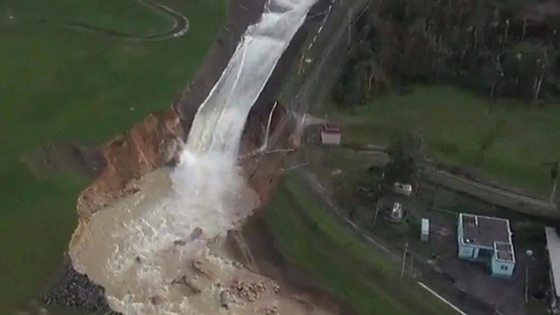
Puerto Rico is facing a growing crisis in the wake of Hurricane Maria, which has knocked out water, electricity, and telephone services.
The entire population is still without power and engineers say it could take months to be restored. A dam remains in danger of collapsing.
Shipments of food, water and generators are starting to arrive at the main port in San Juan, which has reopened.
At least 13 people have died since Maria ripped through Puerto Rico.
The storm, which is now heading to the open waters of the west Atlantic, has caused severe flooding and structural damage.
It damaged telephone masts across the island, and officials from the Federal Emergency Management Agency say they will take satellite phones to towns and cities which have been cut off.
Fallen trees are blocking main highways, whole neighbourhoods remain flooded and many homes are without roofs.
Meanwhile, officials say there is still a risk of flooding on a Puerto Rico river "due to the threat of a failure" of a dam.
The National Weather Service (NWS) have extended flash flood warnings for two areas downstream of Guajataca Dam.
All 70,000 residents in the areas under threat were initially told to flee but there are reports that the evacuation zone has since been narrowed.
Puerto Rico Governor Ricardo Rossello tweeted (in Spanish) that he had assessed the damage to the dam by flying over the area.
Mr Rossello reiterated an earlier call from the authorities for local residents to leave their homes.
The Guajataca Dam, at the northern end of Lake Guajataca in the north-west, began to show signs of failing at 14:10 local time (18:10 GMT) on Friday, operators said.
The NWS on Saturday warned of flash flooding in Isabela and Quebradillas areas.
The agency has been urging residents to move to higher ground in an alert posted on its website.
Mr Rossello earlier called Maria the worst hurricane in a century, warning it could take months to restore electricity to all 3.4 million of the US island territory`s residents.
Maria, a category three storm with maximum sustained winds of nearly 185km/h (115mph), was about 1,030km south-south east from Cape Hatteras in North Carolina, the National Hurricane Center said in its latest update.
"On the forecast track, Maria should move away from the Bahamas into the open waters of the western Atlantic today," the NHC said.
The hurricane has claimed more than 33 lives across the region, and is the second devastating storm to hit the Caribbean this hurricane season.
The first was category five Irma earlier in September.
Maria also caused widespread destruction on the small island of Dominica when it hit on Monday night, leaving at least 15 dead and 20 missing.
US President Donald Trump has pledged to visit Puerto Rico, saying it was "totally obliterated" by the storm.
He has declared the island a disaster area and made federal emergency aid available.


0 comments:
Post a Comment